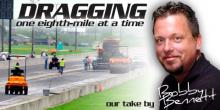DRAG RACING AN EIGHTH OF A MILE AT A TIME
Thu, 2007-03-29 08:20
 It may have started as a way to make chicken salad out of chicken
you-know-what, but the IHRA’s decision to run an eighth-mile national
event may just prove to the drag racing community that short-track
racing is doable. It could be a safer alternative. It could be a
cheaper alternative.
It may have started as a way to make chicken salad out of chicken
you-know-what, but the IHRA’s decision to run an eighth-mile national
event may just prove to the drag racing community that short-track
racing is doable. It could be a safer alternative. It could be a
cheaper alternative. It should be done.
The IHRA’s decision was made for two reasons. First, San Antonio Raceway’s surface began to come apart Friday evening when a well-known dip ultimately gave way, resulting in a potentially dangerous situation. A paving crew was summoned, and they worked throughout the night repairing a large portion of the right lane. That created a curing issue, which could have compromised the newly paved area, rendering it not much better than it was before the work was completed.
Is it time for smaller servings?

It should be done.
The IHRA’s decision was made for two reasons. First, San Antonio Raceway’s surface began to come apart Friday evening when a well-known dip ultimately gave way, resulting in a potentially dangerous situation. A paving crew was summoned, and they worked throughout the night repairing a large portion of the right lane. That created a curing issue, which could have compromised the newly paved area, rendering it not much better than it was before the work was completed.
What’s a race promoter to do? (Please refer to the aforementioned chicken salad.)
The IHRA made the most logical decision possible based on safety and economics, and that was to complete the event with eighth-mile rather than quarter-mile racing. The initial reaction from the competitors was one of disgust and anger. The more the racers looked at the idea of returning home or the expense of housing their teams in Texas for another week, however, the more they realized that cutting the racing surface in half wasn’t that bad an idea. In fact, it soon became viewed as a reasonable alternative.
There were some who never fully warmed up to the idea, including Funny Car driver Bob Gilbertson.
“It won’t cost us as much to race eighth-mile, that’s true,” Gilbertson said. “It’s like I told someone, Live Nation puts on a lot of concerts all the time and they wouldn’t bring the Rolling Stones to play without a stage. This track owner ought to have his butt kicked. Eighth-mile? We’ll probably win.”
Gilby lost in the first round. He was the victim of a driver with a quicker reaction time. That seems to be the largest negative about eighth-mile racing. If you lose the battle on the line, you’ve lost the race. A driver’s R.T. is the great equalizer.
a d v e r t i s e m e n t
Click to visit our sponsor's website
Maybe they shouldn’t depend so much on horsepower. Maybe racers should see the big picture.
The safety issue has everyone looking at every possible idea, from SAFER barriers to eighth-mile racing. Every time a well-known member of the racing community is fatally injured, one of the first things lobbied for by some is a shorter race track. It’s a fact that the majority of fatal accidents in the fuel ranks have occurred on the second half of the race track. Add in the number of fires that break out, and it should make you think. Of course, there will be fires and other issues that result in accidents in eighth-mile racing, but I’m confident that the number will drop significantly. It will also increase the shutdown area to an obviously longer and therefore potentially safer length. Some marginal shutdown areas could increase to a half-mile or even longer.
If it’s safer, then we should consider changing the course of our sport.
Outside of the safety factor, the IHRA has found some interesting data to work with. According to an IHRA official, they shortened their daily operations by a full hour by running an eighth-mile national event. This will only speed up the process even more with refinement, and will, at the same time, make the day that much shorter for the fans.
The racers can and will adjust. The sanctioning body will, too. I have kept this in the singular tense because I highly doubt the NHRA would have taken the same route as the IHRA did in Texas. That is not a dig towards the NHRA, just a cold, hard assessment based on the difference between a “for profit” and “not for profit” business.
I can think of two Pro Stock cars that could have been saved in Columbus one year by scaling back to an eighth-mile program. The NHRA would have never taken a step back because it just isn’t in their nature. Sometimes you have to take two steps back to take one step forward. The IHRA just gained a bit if they choose to take advantage of the situation.
The majority of the nitro drivers applauded the IHRA for the decision.
a d v e r t i s e m e n t
Click to visit our sponsor's website
Top Fuel low qualifier Doug Foley said, “It was interesting and a change of the game. It was just as much of an advantage or disadvantage to everyone out there. It worked out well.”
Foley initially didn’t see a change in the wear and tear of parts, but other drivers did. His assessment is that once the clutch comes in, “all of the parts took a beating.” More data and more laps will enable crew chiefs to either, A) learn ways to gain more life from their components or, B) burn them up quicker. That will determine the budget, as it always has.
This could also open up a new list of potential national event-caliber tracks which, at present, can’t extend their tracks for longer shutdown distances, but provide more than adequate distance for an eighth-mile racing configuration.
The great thing about San Antonio’s predicament is their stadium-style grandstand seating, extending from the starting line to the eighth-mile mark. For the first-time, race fans could see the actual conclusion of the race and not rely solely on the scoreboards for the final result.
Let’s look at the NASCAR model since drag racing’s decision-making hierarchy seems to be more follower than leader. NASCAR has incorporated the short-track venues into their super speedway stops and it certainly works. There were 160,000 fans jammed around the Bristol half-mile for this past weekend’s Cup race, and the same kind of crowd will appear for next weekend’s short track outing in Martinsville, VA.
So there you have my argument for it. To those who were at the event, it was a good thing. Those at home just wouldn’t understand.
Eighth-mile racing is something that has to be experienced in person to be understood. Just ask the ADRL’s Kenny Nowling.
| {loadposition feedback} |
Categories:






































